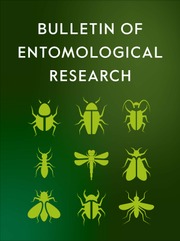No CrossRef data available.
Article contents
Functional response of Chrysoperla externa (Neuroptera: Chrysopidae) to two-spotted spider mite, Tetranychus urticae (Acari: Tetranychidae): Implications for biological control
Published online by Cambridge University Press: 24 June 2025
Abstract
The predator Chrysoperla externa (Neuroptera: Chrysopidae) has great potential for its use in biological pest control programs. In order to assist future biological control programs that use Chrysopidae as a control agent, this research aims to study the behaviour of the green lacewing, C. externa, consuming two-spotted spider mites, Tetranychus urticae (Acari: Tetranychidae). In the laboratory, experiments were carried out to determine the predation behaviour of C. externa on different densities of adults of the two-spotted spider mite, T. urticae (1, 2, 4, 8, 16, 32, and 64 prey). For comparison purposes, the behaviour of C. externa was also studied using eggs from the alternative prey Ephestia kuehniella (Lepidoptera: Pyralidae). The functional response was determined by logistic regression of the number of mites consumed as a function of the initial number of prey using polynomial logistic regression. The random equation was used to describe the parameters of the functional response. The predator C. externa showed a type II functional response consuming both E. kuehniella eggs and T. urticae adults. The results obtained will allow to define the best strategy for the use of green lacewings in the biological control of the two-spotted spider mite, T. urticae.
Keywords
Information
- Type
- Research Paper
- Information
- Copyright
- © The Author(s), 2025. Published by Cambridge University Press.


